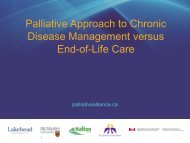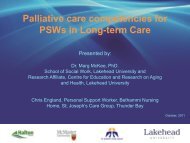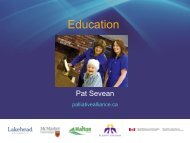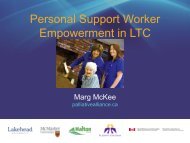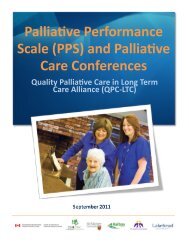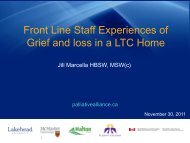Lessons Learned - Quality Palliative Care in Long Term Care
Lessons Learned - Quality Palliative Care in Long Term Care
Lessons Learned - Quality Palliative Care in Long Term Care
- No tags were found...
Create successful ePaper yourself
Turn your PDF publications into a flip-book with our unique Google optimized e-Paper software.
Creat<strong>in</strong>g <strong>Quality</strong> <strong>Palliative</strong> <strong>Care</strong><strong>in</strong> <strong>Long</strong>-<strong>Term</strong> <strong>Care</strong> Homes:<strong>Lessons</strong> <strong>Learned</strong>Symposium Presentation By: Helen Alemany,Diane Crawshaw, Lesley Hirst, SharonKaasala<strong>in</strong>en, Penny Marks, Meaghan Sharp,Nadia Thatcher, Mickey Turner, & AbigailWickson-Griffithspalliativealliance.capalliativealliance.ca
Objectives of Symposium1. Provide an overview of the processesQPC-LTC project2. Describe LTC home and student<strong>in</strong>volvement3. Describe QPC-LTC project <strong>in</strong>terventionspalliativealliance.ca
QPC-LTC Background• By the year 2020, it is estimatedthat as many as 39% of LTCresidents will die each year• These people represent one of society’s most frailand marg<strong>in</strong>alized populations who often strugglewith manag<strong>in</strong>g multiple chronic conditions and socialisolation.palliativealliance.ca
QPC-LTC Background• <strong>Palliative</strong> care is a philosophy and a unique set of<strong>in</strong>terventions that aim to enhance quality of life atthe end of life <strong>in</strong> order to provide a “good death” forpeople, and their family, when death is <strong>in</strong>evitable.palliativealliance.ca
QPC-LTC Background• <strong>Quality</strong> of life at the end of life is understood to bemultidimensional and to consist of physical,emotional, social, spiritual and f<strong>in</strong>ancial doma<strong>in</strong>s.• Most long term care homes do not have aformalized palliative care program that addressthese needs.palliativealliance.ca
QPC-LTC Project Summary• Funded by Social Sciences and Humanities ResearchCouncil (SSHRC) for a five year Community-University Research Alliance• Includes 40 organizational partners and more than30 researchers nationally and <strong>in</strong>ternationally.• 4 LTC home participantspalliativealliance.ca
BethammiNurs<strong>in</strong>g HomeHogarth RiverviewManor• Located <strong>in</strong> Thunder Bay, ON• Owned and operated by St. Joseph’s <strong>Care</strong> Group• Non-profit Catholic organizationpalliativealliance.ca
AllendaleCreekway VillageMilton, ONBurl<strong>in</strong>gton, ON• Owned and operated by the Regional Municipality of Haltonpalliativealliance.ca
Goals of QPC-LTC1. To empower PSWs to maximize their role <strong>in</strong> car<strong>in</strong>g for peoplewho are dy<strong>in</strong>g and their families and support them to becatalysts for organizational changes <strong>in</strong> develop<strong>in</strong>g palliativecare.2. To implement and evaluate a 4-phase process model ofcommunity capacity development <strong>in</strong> four LTC pilot sites, andcreate an research-based tool kit of strategies and<strong>in</strong>terventions to support this development.palliativealliance.ca
Research Design• Comparative Case Study• Two conceptual frameworks– CHPCA Norms of Practice for <strong>Palliative</strong> <strong>Care</strong>– Model for Community Capacity Developmentpalliativealliance.ca
Model for Community CapacityDevelopmentEducationBuild<strong>in</strong>gexternall<strong>in</strong>kagesSufficient <strong>in</strong>frastructure(services, staff, resources)Vision to improve care of dy<strong>in</strong>gpeopleAdvocacyCl<strong>in</strong>ical <strong>Care</strong>Build<strong>in</strong>g communityrelationshipsCollaborative teamapproach to careSense ofempowerment to<strong>in</strong>fluence changeProcess for <strong>Palliative</strong> <strong>Care</strong> DevelopmentSequential phases of thecapacity developmentmodel:4. Grow<strong>in</strong>g the PC Program3. Creat<strong>in</strong>g the PC Team2. Experienc<strong>in</strong>g a Catalyst1. Antecedent conditionspalliativealliance.ca
Methods- Participatory ActionResearch (PAR)• The goal of PAR is to create social change <strong>in</strong> relation to adesired goal through the empowerment of people.• The empowerment process, the change process and itsoutcomes are systematically documented through a variety ofdata collection methods before, after and throughout theresearch process.• PAR recognizes the exist<strong>in</strong>g expertise of LTC staff and promotes<strong>in</strong>tegration of palliative care <strong>in</strong>to exist<strong>in</strong>g practices.palliativealliance.ca
Research Timel<strong>in</strong>e• Year 1 – Environmental Scan <strong>in</strong> each home to create basel<strong>in</strong>eunderstand<strong>in</strong>g us<strong>in</strong>g CHPCA norms of practice• Year 2 – Create <strong>in</strong>terprofessional PC teams and identify <strong>in</strong>itial<strong>in</strong>terventions based on evidence• Year 3 – 4 Develop PC program with PSW and community partners.• Year 5 – Evaluate change and susta<strong>in</strong>ability of changes Createevidence based toolkit of successful <strong>in</strong>terventions• Year 5 onwards – Promote change <strong>in</strong> policy, practice and education.palliativealliance.ca
<strong>Long</strong>-<strong>Term</strong> <strong>Care</strong> HomePerspectiveHelen Alemany, RNFormer Director of <strong>Care</strong>, Allendalepalliativealliance.capalliativealliance.ca
Engagement <strong>in</strong> QPC-LTC• Recognized need for QPC <strong>in</strong> LTC homes• Improve PC practices• Enthusiasm for project throughout LTChomepalliativealliance.ca
Strategies for Success• Recogniz<strong>in</strong>g PSW presence <strong>in</strong> provid<strong>in</strong>gQPC <strong>in</strong> LTC• Select<strong>in</strong>g passionate PSW leads forproject• Coord<strong>in</strong>ated data collectionpalliativealliance.ca
Student PerspectiveAbigail Wickson-Griffiths, RN, MNStudent Tra<strong>in</strong>eepalliativealliance.capalliativealliance.ca
Engagement <strong>in</strong> QPC <strong>in</strong> LTC• 20 students have participated <strong>in</strong> project• Tra<strong>in</strong><strong>in</strong>g– LTC sett<strong>in</strong>g/ <strong>Palliative</strong> <strong>Care</strong>– Research process• PAR method• Data collection and analysis• Interaction and <strong>in</strong>volvement with LTC staff• Mentor<strong>in</strong>gpalliativealliance.ca
Interventionspalliativealliance.capalliativealliance.ca
QPC-LTC – The Hospice RoleLesley Hirst RGN (UK), RN, MN, MSc (c)palliativealliance.capalliativealliance.ca
BackgroundThe Carpenter Hospice – 10 bed residential hospice,Burl<strong>in</strong>gton ON– Staff <strong>in</strong>clude RNs, RPNs, PSWs, APN– Assist with the placement for PSWs from LTC– End-of-life care is a component of palliative care– <strong>Palliative</strong> care approach should be delivered fromdiagnosispalliativealliance.ca
Mentor<strong>in</strong>g PSWs from LTC• PSWs come to work at the hospice for 2 daysand work alongside PSW staff– Objectives reviewed– Work together <strong>in</strong> pairs• Talk about the philosophy of deliver<strong>in</strong>g end-of-life care• Barriers <strong>in</strong> LTC• What they can take back to LTCpalliativealliance.ca
Description of Intervention #1• Why is this important?• PSWs get focused on “tasks” <strong>in</strong> LTC• In hospice all members of the team are <strong>in</strong>tegralto achiev<strong>in</strong>g the goals of care• The residents benefit – the staff benefitpalliativealliance.ca
Intervention Cont<strong>in</strong>ued• Understand how deliver<strong>in</strong>g care to people who aredy<strong>in</strong>g does not necessarily mean you deliver<strong>in</strong>ggood quality palliative care• Breaks down myths associated with workload andcare delivery• Discussion at a wider level – all project members getto discuss palliative care and future directionspalliativealliance.ca
Outcomes• The hospice is thought of as a ‘Centre of Excellence’• Hospice PSWs feel empowerment as mentors• LTC PSWs benefit from:– Learn<strong>in</strong>g new ways to approach work– Bra<strong>in</strong>storm<strong>in</strong>g to identify solutions to barriers– New resources and larger network to pull from– Empowerment from new knowledgepalliativealliance.ca
Watch for Negative Outcomes• Resistance to change <strong>in</strong> LTC• PSWs feel<strong>in</strong>g overwhelmed with mentor<strong>in</strong>g• PSWs from LTC feel<strong>in</strong>g disillusioned when theyreturnpalliativealliance.ca
Reflections• Recommend other hospices partner with LTC• Susta<strong>in</strong>ability: The LTC system needs to beaddressed and barriers broken down• Labell<strong>in</strong>g patients/residents still exists• <strong>Palliative</strong> care is an approach, end-of-life carefits <strong>in</strong>to palliative carepalliativealliance.ca
PSW Perspectiveon Hospice VisitsPenny Marks, PSW, Creek Way Village,Burl<strong>in</strong>gtonpalliativealliance.capalliativealliance.ca
PSWs Reflections• 6 visit<strong>in</strong>g PSWs• 2 - Hospice Northwest,Thunder Bay• 4 - Carpenter Hospice, Burl<strong>in</strong>gton• Standardized questionnairecompleted by participantspalliativealliance.ca
Emerg<strong>in</strong>g Themes• High value of PSW role at hospice- Inter-professional <strong>Care</strong> Conference“A ‘huddle’ occurred when I firstarrived on the H/PCU where allthe team members discussed thepatients on the unit and eachgave a report [ . . . ] everyonehad their chance to say theirpiece about the patients.”palliativealliance.ca
Emerg<strong>in</strong>g Themes• Communication between IP Team- Tools used <strong>Palliative</strong> Performance Scale(PPS) & <strong>Palliative</strong> Prognostic Index (PPI)“Of course people are <strong>in</strong> charge but still on the‘floor/frontl<strong>in</strong>e’ no ‘them & us’ mentality tostand <strong>in</strong> the way of care.”palliativealliance.ca
Emerg<strong>in</strong>g Themes• Resident Centered <strong>Care</strong>- Not task focused“They went by the patient’s schedule and gotthem out of bed when the patient wanted toget out of bed.”palliativealliance.ca
Next Steps• Increase IP learn<strong>in</strong>g“I did however feel uncomfortable with my lackof knowledge of medication effects.”• Ensure the effective uptake of lessonslearned from hospice to LTC sett<strong>in</strong>gpalliativealliance.ca
Snoezelen TherapyNadia Thatcher RN, HBScNMeaghan Sharp RN, BScN, MN, CEN, MBA (c)palliativealliance.capalliativealliance.ca
Background• Directors of <strong>Care</strong>• St Joseph’s <strong>Care</strong> Group (SJCG), <strong>Long</strong>-term<strong>Care</strong> (LTC)• Leadership support and guidancepalliativealliance.ca
Snoezelen Therapy• Multi-Sensory Stimulation Therapy–What is Snoezelen Therapy???• Provides residents with a pleasurable experienceand sense of well-be<strong>in</strong>g• Based on the <strong>in</strong>dividual resident plan of carepalliativealliance.ca
Description of Intervention #2• Use of Snoezelen therapy was limited to Life Enrichmentstaff• Development of a tra<strong>in</strong><strong>in</strong>g toolkit for families, volunteersand staff• Delivery of education to all groups• Goal: Increase the utilization of Snoezelen therapy• All residents will benefitpalliativealliance.ca
Outcomes• Interprofessional approach to therapy,<strong>in</strong>clud<strong>in</strong>g family and volunteers• PSW’s lead<strong>in</strong>g change• Measureable cl<strong>in</strong>ical outcomes• Improves the quality of life of residentspalliativealliance.ca
Outcomes• Areas for improvement– Communicate Snoezelen therapy toresidents/families, volunteers and staff– More tra<strong>in</strong><strong>in</strong>g opportunities to staff, volunteers,family and residents– Referral process for residents who would benefitfrom Snoezelen therapypalliativealliance.ca
Reflections• Increased recognition of PSW leadership• Cont<strong>in</strong>ued leadership presence• Snoezelen therapy aligns with– resident centred model of care– <strong>in</strong>terprofessional approach to resident care• Empowers families and volunteerspalliativealliance.ca
Spiritual <strong>Care</strong> InterventionDiane Crawshaw, Project Coord<strong>in</strong>atorMcMaster Universitypalliativealliance.capalliativealliance.ca
SpiritSpirituality is that part ofeach <strong>in</strong>dividual whichlongs for mean<strong>in</strong>g,<strong>in</strong>tegrity, beauty, dignity,hope, love andacceptance.~ Vitaspalliativealliance.ca
Background• Allendale LTC, Milton• 200 beds• Municipally funded• Secular• 40 resident deaths last year• Identified a gap <strong>in</strong> spiritual care• Family Council requested an onsite chapla<strong>in</strong>palliativealliance.ca
Intervention #3• Luc<strong>in</strong>da Landau, MDiv, Dm<strong>in</strong>• Cl<strong>in</strong>ical Chapla<strong>in</strong>, CASC• Chapla<strong>in</strong>cy Research Associate• Available 4 hours per week• Address<strong>in</strong>g juxtaposition of care-giv<strong>in</strong>gwith marked exposure to community deathpalliativealliance.ca
Intervention Cont<strong>in</strong>ued• Resources for spiritual and palliative carevolunteers to be evaluated and refreshed• Will this <strong>in</strong>tervention make a difference tothe quality of life for residents, family andstaff?palliativealliance.ca
Outcomes - Prelim<strong>in</strong>ary• Spiritual care provided through referral and selfidentification• Collaboration among volunteers to streaml<strong>in</strong>ereferrals, enrich tra<strong>in</strong><strong>in</strong>g and resources• Consultation with community partners• Creation of comprehensive bereavement programpalliativealliance.ca
ReflectionsWhat might work better:• Chapla<strong>in</strong> researcher and volunteerchapla<strong>in</strong> to chart resident visits• Integrat<strong>in</strong>g residents as volunteers• Track<strong>in</strong>g all spiritual care volunteer visitspalliativealliance.ca
Future Steps• Encourage Cl<strong>in</strong>ical Pastoral Education students touse Allendale for cl<strong>in</strong>ical placements• Better <strong>in</strong>tegration of Spiritual <strong>Care</strong> Providers to theInterprofessional team• Recognize need for staff to communicate griefissues/ compassion fatigue-Room Bless<strong>in</strong>gspalliativealliance.ca
Comfort <strong>Care</strong> RoundsMickey Turner RN CHPCN(C)palliativealliance.capalliativealliance.ca
Background• <strong>Palliative</strong> Pa<strong>in</strong> and Symptom ManagementConsultant• One of approximately 26 consultants <strong>in</strong> Ontariosupported by MOHLTC• Community partner QPC-LTC• Involved with two of the four LTC homesparticipat<strong>in</strong>g <strong>in</strong> projectpalliativealliance.ca
Intervention # 4• Monthly Comfort <strong>Care</strong> Rounds• Began as Pa<strong>in</strong> Rounds stemm<strong>in</strong>gfrom desire of LTC staff to haveeducation on pa<strong>in</strong> management• Interdiscipl<strong>in</strong>ary (manager, nurses,PSW, rehab, pharmacy, NP,volunteers, spiritual workers, PRC)• Sessions once a month for 30-60 m<strong>in</strong>utes• Held off units <strong>in</strong> LTCHpalliativealliance.ca
Outcomes• Knowledge of pa<strong>in</strong> management improvednursesstopped attend<strong>in</strong>g• Realized need to be flexible• Format <strong>in</strong> each home is unique based on theirown needspalliativealliance.ca
Outcomes• Morphed <strong>in</strong>to Comfort <strong>Care</strong> Rounds– less focus on pa<strong>in</strong> and focused on myriad of EOL issues– discuss any issues around recent deaths (good and bad)– discuss specific resident issues (pa<strong>in</strong>, communicationchallenges)– often an education component as determ<strong>in</strong>ed by staff• Staff started attend<strong>in</strong>g aga<strong>in</strong>palliativealliance.ca
Challenges• Compet<strong>in</strong>g with other <strong>in</strong>itiatives (M<strong>in</strong>istry visits,MDS, Po<strong>in</strong>t-Click <strong>Care</strong>, etc)• Time off units• Gett<strong>in</strong>g other members to attend (especiallyPSW’s)palliativealliance.ca
ReflectionsThrough Involvement of the Project:• Increased participation of PSWs <strong>in</strong> monthly rounds• Ability to address some of needs expressed <strong>in</strong> surveysconducted by research team (ACP, spirituality, etc)• Potential for <strong>in</strong>volvement <strong>in</strong> future education needs ofLTC staff us<strong>in</strong>g Comfort <strong>Care</strong> forum or by other meanspalliativealliance.ca
Wrap Up• Questions??• Thank you!palliativealliance.ca



